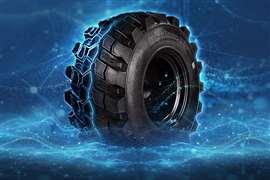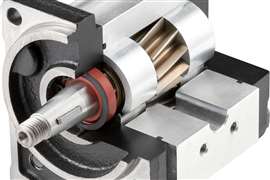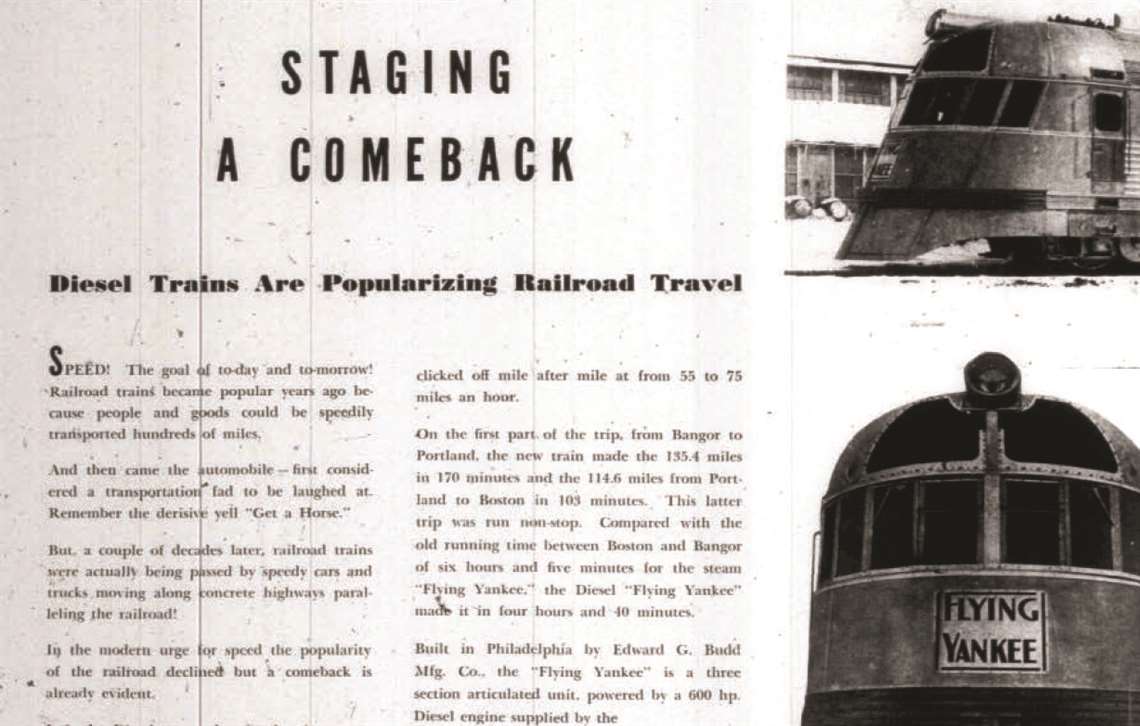Read this article in Français Deutsch Italiano Português Español
How has the industry changed in 90 years?
16 May 2025
A review of the heritage of Power Progress through issues published since 1935.
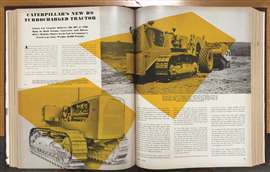 1955: The May 1955 issue introduced Caterpillar’s D9 track-type tractor with its six-cylinder Cat diesel engine rated 286 hp and its two-cylinder starting engine. The engine of the “light-footed giant” in the article sported a new T15 turbocharger from the Phoenix-based AiResearch Industrial Div. of Garrett Corp. The 56,000-lb. machine was the result of 10 years of R&D at Caterpillar. Development of the turbo was covered in depth, including the whirl testing they were subjected to for “hundreds of hours at speeds 10% higher than encountered under maximum diesel engine ratings.” International Harvester’s TD-24 Torque Converter diesel crawler was profiled, and four wheeled construction machines from Allis-Chalmers were rolled out. Diesel equipment was ready for the Federal-Aid Highway Act that was signed into law in ‘56, authorizing the construction of 41,000 miles of interstate in the U.S.
1955: The May 1955 issue introduced Caterpillar’s D9 track-type tractor with its six-cylinder Cat diesel engine rated 286 hp and its two-cylinder starting engine. The engine of the “light-footed giant” in the article sported a new T15 turbocharger from the Phoenix-based AiResearch Industrial Div. of Garrett Corp. The 56,000-lb. machine was the result of 10 years of R&D at Caterpillar. Development of the turbo was covered in depth, including the whirl testing they were subjected to for “hundreds of hours at speeds 10% higher than encountered under maximum diesel engine ratings.” International Harvester’s TD-24 Torque Converter diesel crawler was profiled, and four wheeled construction machines from Allis-Chalmers were rolled out. Diesel equipment was ready for the Federal-Aid Highway Act that was signed into law in ‘56, authorizing the construction of 41,000 miles of interstate in the U.S.
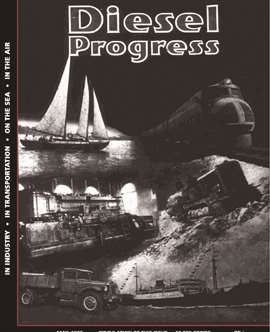 1935
1935
“Something new – something economical. After all is said and done, that is what the diesel engine really is – something new, something economical. Despite the fact that oil burning engines have been in use for 25 years or so in this country, it has only been since the big slide started back there in 1929 that the diesel really started coming into its own.”
That’s the first paragraph in Rex Wadman’s editorial in Vol. 1 No. 1 of Diesel Progress – today’s Power Progress. Wadman was editor and publisher of the publication, which has been published every year since then.
Those early years were firmly rooted in promoting the compression ignition engine, but as the industry evolved so too did Diesel Progress. The coverage presented by the editors (as well as the advertisers) expanded to engines of other fuel types and eventually traveled through the entire drivetrain. Then, too, control systems appeared on the scene, at first mechanical, then hydraulic and then electronic.
To reflect the changes in coverage, the name of the publication has changed often, most recently in 2024 when Diesel Progress became Power Progress. These days, end users and design engineers have more options – always something new – at their disposal.
Going through the years
With this feature, we’ll open a May issue from each decade since the fifth month of 1935. From low- and high-speed diesel engines to the coverage of the entire machine from front to back, the back issues preserve the history of the industry.
Note each thumbnail below opens into a fullscreen gallery.
 1935: : “Speed! The goal of today and tomorrow! Railroad trains became popular years ago because people and goods could be speedily transported hundreds of miles,” read an article in the May 1935 issue. “And then came the automobile - first considered a transportation fad to be laughed at. Remember the derisive yell ‘Get a horse.’ But, a couple of decades later, railroad trains were actually being passed by speedy cars and trucks moving along concrete highways paralleling the railroad! In the modern urge for speed the popularity of the railroad declined but a comeback is evident. It is the diesel-powered train that is responsible.”
1935: : “Speed! The goal of today and tomorrow! Railroad trains became popular years ago because people and goods could be speedily transported hundreds of miles,” read an article in the May 1935 issue. “And then came the automobile - first considered a transportation fad to be laughed at. Remember the derisive yell ‘Get a horse.’ But, a couple of decades later, railroad trains were actually being passed by speedy cars and trucks moving along concrete highways paralleling the railroad! In the modern urge for speed the popularity of the railroad declined but a comeback is evident. It is the diesel-powered train that is responsible.”
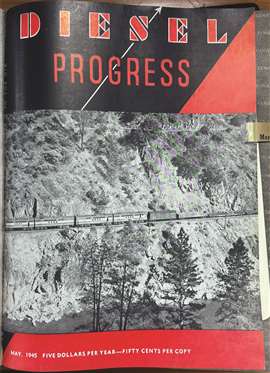 1945: A General Motors diesel-electric locomotive pulls a 4,000-ton freight train through Feather River Canyon in California and across the May 1945 issue. “Diesels clear war wreckage” was a sobering spread of photos supplied by the Signal Corps wherein crawlers worked in destroyed cities around Europe. Elsewhere, articles and advertisements focused on ways to save money and resources and maintain the equipment that was already part of a fleet. Three diesel engines powered a flourspar mine in Colorado. The mineral was critical to the war effort, and the U.S. was a major producer.
1945: A General Motors diesel-electric locomotive pulls a 4,000-ton freight train through Feather River Canyon in California and across the May 1945 issue. “Diesels clear war wreckage” was a sobering spread of photos supplied by the Signal Corps wherein crawlers worked in destroyed cities around Europe. Elsewhere, articles and advertisements focused on ways to save money and resources and maintain the equipment that was already part of a fleet. Three diesel engines powered a flourspar mine in Colorado. The mineral was critical to the war effort, and the U.S. was a major producer.
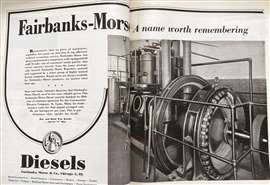 1945
1945
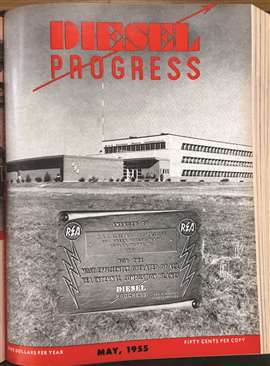 1955
1955
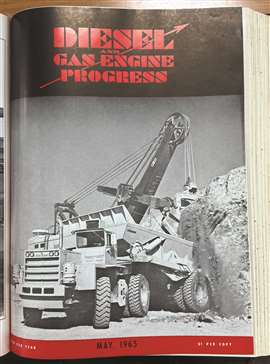 1965
1965
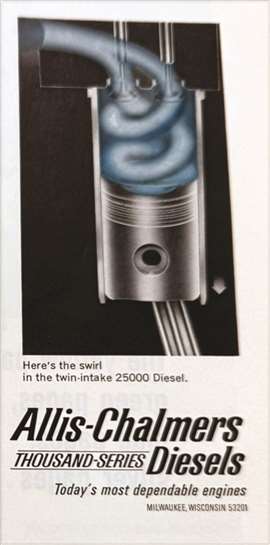 1965
1965
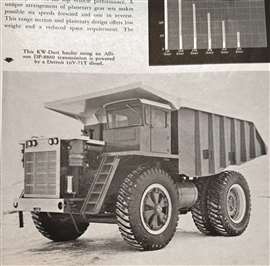 California’s New Exchequer Dam project involved raising an existing 320-ft. tall dam another 170 ft. with 5.5 million cu. yd. of rock and adding a concrete slab 30 in. thick on the face. To get it done, the contractor bought millions of dollars of new equipment, including eight KW-Dart dump trucks with 110-ton capacities. The real story, however, was the work Allison did to ensure its transmissions stood up to more power, such as the 700-hp Cummins VT12-700 diesel engines the contractor used in those trucks.
California’s New Exchequer Dam project involved raising an existing 320-ft. tall dam another 170 ft. with 5.5 million cu. yd. of rock and adding a concrete slab 30 in. thick on the face. To get it done, the contractor bought millions of dollars of new equipment, including eight KW-Dart dump trucks with 110-ton capacities. The real story, however, was the work Allison did to ensure its transmissions stood up to more power, such as the 700-hp Cummins VT12-700 diesel engines the contractor used in those trucks.
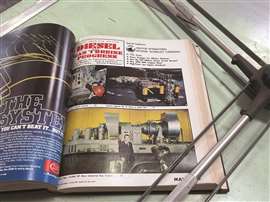 1975, By May 1975, the name was Diesel and Gas Turbine Progress. Its editors highlighted Solar’s 10,000-hp gas turbine for industrial applications and White Superior’s high-horsepower 12- and 16-cylinder gas engines. Ingersoll-Rand picked a low-noise Deutz F4L 912 diesel engine for its portable air compressors, prompting the writer to note that “air-cooled engines are gradually moving into areas of application that were once the primary domain for the water-cooled diesel.” In spite of the magazine’s cumbersome name, it was not just focused on engines (and turbines). Rockwell’s hydraulic track drives were compact but used the gear technology for which the company was known. Color photos were reserved for the cover and a few extra-cost ads.
1975, By May 1975, the name was Diesel and Gas Turbine Progress. Its editors highlighted Solar’s 10,000-hp gas turbine for industrial applications and White Superior’s high-horsepower 12- and 16-cylinder gas engines. Ingersoll-Rand picked a low-noise Deutz F4L 912 diesel engine for its portable air compressors, prompting the writer to note that “air-cooled engines are gradually moving into areas of application that were once the primary domain for the water-cooled diesel.” In spite of the magazine’s cumbersome name, it was not just focused on engines (and turbines). Rockwell’s hydraulic track drives were compact but used the gear technology for which the company was known. Color photos were reserved for the cover and a few extra-cost ads.
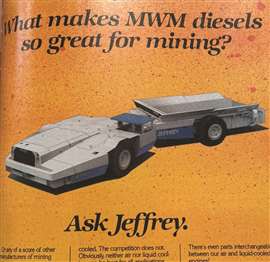 1985
1985
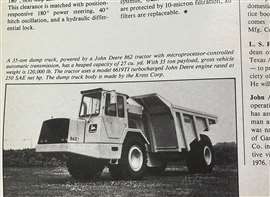 1985. May’s Diesel Progress North American focused on the engines of the oil & gas industry, with a shot of the Western Pacesetter IV drill rig on the cover. The U.S. economy was rebounding from a deep recession that hit equipment makers hard. Allis-Chalmers closed its tractor factory near Milwaukee, Wis., and was sold to Germany’s KHD and Daimler-Benz acquired MAN’s share of engine builder MTU. Even oil & gas was ailing: a multi-source feature told what “computerized maintenance” could mean for cost savings. “File upon file of information has been accumulated but retrieval is so cumbersome, the value of this historical data is limited,” said a maintenance manager.
1985. May’s Diesel Progress North American focused on the engines of the oil & gas industry, with a shot of the Western Pacesetter IV drill rig on the cover. The U.S. economy was rebounding from a deep recession that hit equipment makers hard. Allis-Chalmers closed its tractor factory near Milwaukee, Wis., and was sold to Germany’s KHD and Daimler-Benz acquired MAN’s share of engine builder MTU. Even oil & gas was ailing: a multi-source feature told what “computerized maintenance” could mean for cost savings. “File upon file of information has been accumulated but retrieval is so cumbersome, the value of this historical data is limited,” said a maintenance manager.
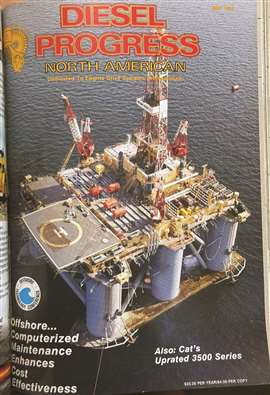 1985
1985
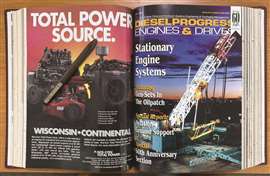 1995
1995
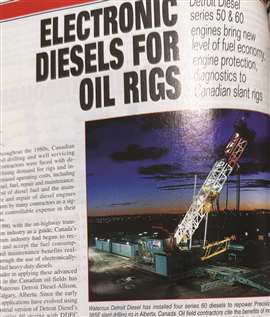 1995. This was the 60th anniversary issue of what was then known as Diesel Progress Engines & Drives (name changes are not new to this publication). Engines, drivetrains and hydraulic components were an important part of the magazine. It was still an “engine book,” however. Canada’s petroleum industry had great success with Detroit Diesel’s electronically controlled 12.7 L Series 50 and 60 diesel engines while Olathe, Kan.-based Lister-Petter Inc. announced it received CARB emissions certifications for three small diesel engines. John Deere Power Systems expanded its “emissions-era” diesel range with a 4.5 L and a 6.8 L engine.
1995. This was the 60th anniversary issue of what was then known as Diesel Progress Engines & Drives (name changes are not new to this publication). Engines, drivetrains and hydraulic components were an important part of the magazine. It was still an “engine book,” however. Canada’s petroleum industry had great success with Detroit Diesel’s electronically controlled 12.7 L Series 50 and 60 diesel engines while Olathe, Kan.-based Lister-Petter Inc. announced it received CARB emissions certifications for three small diesel engines. John Deere Power Systems expanded its “emissions-era” diesel range with a 4.5 L and a 6.8 L engine.
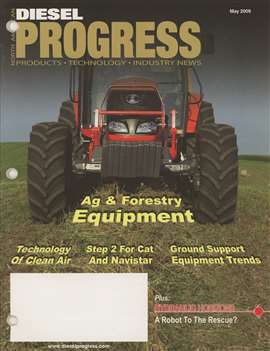 2009. From May 1995, this 90th anniversary survey of past issues will now jump over May 2005 and land on May 2009. It was still very much the “emissions era.” An article titled “Preparing the off-road toolbox” told how BASF Catalysts planned to help off-road equipment manufacturers meet upcoming emissions regulations, and a feature about airport ground support equipment predicted an electric future. The issue was home to regular departments with headings such as “Emissions & Alternatives” and “Technology of Clean Air.” Many of those articles could be seen pulled out of the magazine and tacked to cubicle walls in engineering departments nationwide.
2009. From May 1995, this 90th anniversary survey of past issues will now jump over May 2005 and land on May 2009. It was still very much the “emissions era.” An article titled “Preparing the off-road toolbox” told how BASF Catalysts planned to help off-road equipment manufacturers meet upcoming emissions regulations, and a feature about airport ground support equipment predicted an electric future. The issue was home to regular departments with headings such as “Emissions & Alternatives” and “Technology of Clean Air.” Many of those articles could be seen pulled out of the magazine and tacked to cubicle walls in engineering departments nationwide.
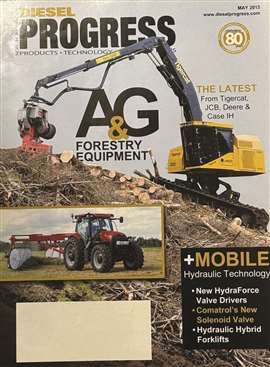 2015
2015
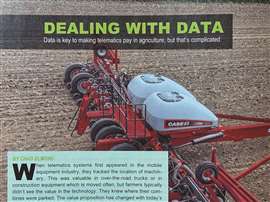 2015. It was the year Tier 4 Final emissions standards became the rule of off-highway equipment. Forestry machines got a feature following a visit with Tigercat Industries in Ontario, Canada, to report on what steps the OEM took to meet those regulations with the help of its engine supplier, FPT Industrial. Machine control was front and center, enhanced by new valve drivers introduced by HydraForce designed for variable fan drives, mobile equipment booms and transmission shifting. Maintenance got some attention again, as well, this time aided by data generated by the machine itself.
2015. It was the year Tier 4 Final emissions standards became the rule of off-highway equipment. Forestry machines got a feature following a visit with Tigercat Industries in Ontario, Canada, to report on what steps the OEM took to meet those regulations with the help of its engine supplier, FPT Industrial. Machine control was front and center, enhanced by new valve drivers introduced by HydraForce designed for variable fan drives, mobile equipment booms and transmission shifting. Maintenance got some attention again, as well, this time aided by data generated by the machine itself.
POWER SOURCING GUIDE
The trusted reference and buyer’s guide for 83 years
The original “desktop search engine,” guiding nearly 10,000 users in more than 90 countries it is the primary reference for specifications and details on all the components that go into engine systems.
Visit Now
STAY CONNECTED




Receive the information you need when you need it through our world-leading magazines, newsletters and daily briefings.
CONNECT WITH THE TEAM











